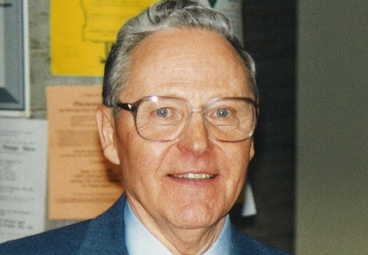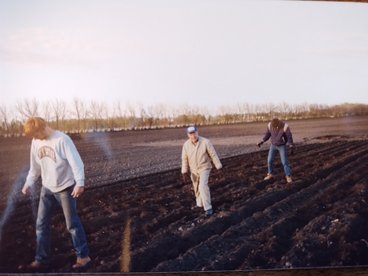
Emeritus Professor Neil A. Anderson passed away on Friday, January 19, 2024, at the age of 95. From student to faculty member and eventually department head, Anderson devoted his career to the University of Minnesota Department of Plant Pathology. His impact in plant pathology research and education, as well as the positive advising and mentorship he provided for his students, will be remembered throughout the University of Minnesota community and beyond.
Read all submitted memories of Neil here.
Of mycology and mentorship
Anderson first joined the department as a PhD student. In 1998’s Aurora Sporealis, Anderson cites EC Stakman, JJ Christensen, Louise Dosdall, and Carl Eide as the educators who instilled in him a love of plant pathology, as well as a passion for mentoring the next generation of scientists. He brought this love of mentorship to the forefront of his career when he became a professor right here in the department, telling Aurora Sporealis “I have been privileged to have helped 41 graduate students; the wonderful part of this experience is that it continues as their personal and professional careers develop.” He welcomed students into his research of fungal genetics, which included research on fungal diseases of conifers and potatoes as well as mycorrhizal fungi.

Former students remember Neil as a positive role model who brought both knowledge and encouragement to their studies. “In 1982 I was one of the first students to be interested in doing molecular biology,” recalls Jenny Lorang (MS ‘88). “He encouraged me and said it was great, but he said ‘We will make sure you are a biologist first. Always keep on foot in the furrow.’ Great advice!”
Linda Kinkel recalls witnessing Neil’s wisdom in the field, even at unexpected moments: “He always insisted on a break at lunchtime. He would want everyone to sit down at the old picnic table at the Becker field station, and he would pull out a napkin, onto which he would place his lunch items. It was all very civilized and in some ways even meditative, while I would've been happy to have the team GO GO GO and work through lunch with quick breaks in rotation. Now, with the wisdom of age, I think that Neil was absolutely correct. Pacing oneself and taking breaks are two gifts of insight that Neil gave us.”
Neil took care of his students beyond research, too. “While working on my doctoral dissertation research in the USDA Forest Service annex,” recalls James Jacobs (PhD ‘08), “Neil noticed I had been putting in some late hours and clearly thought I needed to eat more food, a common problem for graduate students. At about 7pm Neil walked into the headhouse while I was dissecting stems with a giant tray of food plated on old school dinner china. Pot roast, mashed potatoes, gravy boat, dinner rolls, mixed vegetables and a glass of water. The works! We talked for a few minutes and said he would grab the dishes in the morning and he hoped they would be empty, then walked out.”
The joy of research
The care and passion Neil brought to his research, as well as the findings of his work, inspired many who followed in his footsteps.
“Neil was meticulous. His work revealed the role of branch stubs in Hypoxylon canker which had baffled forest pathologist for decades,” recalls Fred Baker (PhD ‘81). “Neil’s eyes would get bright when he talked about his work with Hypoxylon canker.”

He carried on his passion for research beyond his tenure in the department, including as a USDA Forest Service Northern Research Station volunteer. Juzwik recalls watching him with his longtime collaborator Mike Ostry: “I enjoyed watching them work together in the laboratory and their excitement of new discoveries and admired their close, 35 plus years long relationship.”
Bob Blanchette recalls Neil as a supportive colleague: “When I first arrived in the department, all of the faculty offices were full and there was no office available. Neil Anderson was such a kind and generous person that he opened his office to me and shared his space for over a year. This act of kindness touched me deeply and that first year was full of wonderful memories of shared discussions and superb mentoring that I received. How lucky I was to be able to experience the everyday activities of a distinguished professor up close and personal during that year in a shared office. During the several decades that followed, I found Neil’s mycological investigations were extraordinary endeavors. He had wide interests in fungal genetics, Verticillium and potato diseases as well as fungi that were associated with trees. He did pioneering work on Hypoxylon canker, mycorrhizal fungi including Lacarria, tree seedling diseases, hybrid poplar diseases and many others. His work was always superb and over time, I found that his kindness and generosity to others never dwindled. He was a great scientist, a fine gentleman and a joy to have known.”
His impact even extended beyond those who he mentored directly into the larger community. Brett Arenz (PhD ‘10) recalls, “Neil had already retired when I started as a graduate student in 2003 but I recall that he maintained some small research projects and frequently stopped by the Forest Pathology lab to chat about science. As I was just starting my scientific career it was nice to see that passion for the field still burning bright in someone on the other end of his career. He was an exceedingly kind, humble, and pleasant person to interact with and it always brightened my day when I bumped into him around campus.”
Neil proved himself to be the kind of researcher who welcomes others into the field. Kinkel shared: “Fundamentally and profoundly, I would have never fallen in love with and dedicated my research career to Streptomyces if Neil hadn't come to my office and said… there is this disease-suppressive soil that I think you should look at...”
Lasting legacy
Neil was an exceptional role model to those who studied under him, building a lasting positive culture. “As a current researcher in the area of Public Health,” said Andy Ryan, “I often think of Dr. Anderson, who had a strong passion for his research and conducted it with integrity, patience, and kindness to others. He was one of those people who helped inform my decisions long after I left the Department of Plant Pathology.”
“Above all, his kindness and human warmth was extraordinary as well as his dedication to the students. Being an outstanding plant pathologist, his modesty and empathy was an example to follow,” recalls Nora Altier (PhD ‘97). “His legacy transcends the department and the UMN; he was an example of life, Neil has impressed on my own professional career as well as on the way I fill the backpack of human values.”
“He was an incredible exemplar of the land grant mission,” adds Kinkel. “His deep legacy is in his students and colleagues, his sharing of his passion for fungi, his willingness to share his knowledge with all, and his joy in science.”
To end on words from Tarkus Suganda (PhD ‘95): “Prof Anderson's legacy will endure through the countless lives he touched, and the knowledge he imparted will continue to inspire and guide us in our future endeavors. During this time of grief, let us remember the joy and knowledge he shared, the challenges he helped us overcome, and the wisdom he imparted. Neil and his beloved wife, Barbara, will be remembered by my wife, our daughter, and myself, as a very kind couple who invited us several times to their lovely house. As we mourn his loss, let us also celebrate the extraordinary life of a remarkable mentor who dedicated himself to the pursuit of knowledge and the development of those around him.”
